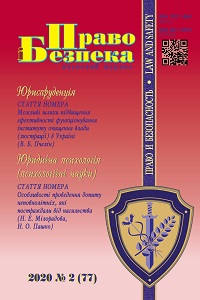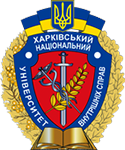The genesis of forensic research of documents as the branch of forensic technology
Abstract
The history of the falsification of various documents for illegal purposes accompanies the entire history of human civilization, so the study of the evolution of methods of documenting information and related methods of forgery is one of the methods of improving forensic knowledge. The examination of documents similarly has a long history and is directly related to the emergence and spread of writing.
At the present stage of development of forensic document research, the achievements of various sciences are actively used to reveal the patterns in the field of forensic technology and its improvement. In particular, the study of the anatomical characteristics of writing and motor skills during the analysis of certain elements of handwriting; physiological processes that form the basis of movement control and reproduce written features or their combinations. The coordination of movements in the distribution of manuscripts according to the pace of writing is separately studied. Factors influencing the formation of written speech are determined by
conducting experiments. Internal and external factors are taken into account, which allow to reconstruct the psycho-physiological features of the person who wrote the document, without which the establishment of its authorship is extremely problematic. Data of physiology and psychology help in the process of substantiating the stability of handwriting elements, drawing parallels between psycho-physiological characteristics of a person and certain graphic features.
Considering the acquired historical experience, modern forensic research can be divided into three categories: 1) handwriting, where the main purpose is to establish the executor of the document; 2) auto-research – finding out the authorship of the text of the document; 3) technical and forensic, which allow to accurately establish the remaining components of the document.
Forensic examination of documents has passed a long way in historical evolution. In its modern form, it was developed in the second half of the XX century due to a combination of theoretical principles and special methods borrowed from the natural and technical sciences. It allowed to determine as accurately as possible the technical features of producing a document or its part thereof, identifying the used tools and materials.
Downloads
References
Tregubov S., 1930. Forensic examination of documents (its current position) [Sudebnaya ekspertiza dokumentov (sovremennoe ee polozhenie)]. Zakon i Sud: Vestnik Russkogo yuridicheskogo obshchestva, No. 16, pp. 507-510.
Bikmaeva N., 2006. Historical and forensic trends in the development of forensic expertise and forensic expert institutions in Russia (XIX – late XX century) [Istoriko-kriminalisticheskie tendentsii razvitiya sudebnoi ekspertizy i sudebnykh ekspertnykh uchrezhdenii Rossii (XIX – konets XX veka)]. Abstract of Ph.D. dissertation. Nizhny Novgorod State University named after N. I. Lobachevskyi.
Rossinskaya E. and Zinin A., 2015. History of the formation and development of the institution of forensic examination in Russia [Istoriya stanovleniya i razvitiya instituta sudebnoi ekspertizy v Rossii]. Vestnik Universiteta imeni O. E. Kutafina – Courier of the Kutafin Moscow State Law University, No. 12, pp. 18-37.
Rossinskaya E., 1999. Profession expert. Introduction to the legal profession [Professiya ekspert. Vvedenie v yuridicheskuyu spetsial'nost]. Moscow: Yurist``.
Krylov I., 2006. Selected works on criminalistics [Izbrannye trudy po kriminalistike]. St. Petersburg: Yuridicheskii fakul`tet SPbGU.
Kharichkina I., 2019. Forensic service in the system of the Ministry of Internal Affairs is 100 years old [Ekspertno-kriminalisticheskoi sluzhbe v sisteme MVD 100 let]. Vestnik Ûžno-Uralʹskogo gosudarstvennogo universiteta. Seriâ Pravo – Bulletin of the South Ural State University. Series "Pravo", Vol. 19, No. 2, pp. 117-122.
Remer V., 1818. Police and forensic chemistry [Politseiskaya i sudebnaya khimiia]: in 2 parts. Part 1. St. Petersburg: Meditsinskaya tipografiya. (Transl.: Gaevskii S.).
Lavrov V., 1994. Forensic examination: emergence, formation and development trends [Kriminalisticheskaya ekspertiza: vozniknovenie, stanovlenie i tendentsii razvitiya]. Moscow: YuIMVDRF.
Shelepkova S.M., Perlin S.I., Shevtsov S.O. et al., 2010. The criterion of truth is experience. Chronicle of the Expert Service of Kharkiv Region [Kryteriyem istyny ye dosvid. Litopys Ekspertnoi sluzhby Kharkivshchyny]. Kharkiv.
Krylov I., 1963. Forensic examination in the criminal process [Sudebnaya ekspertiza v ugolovnom protsesse]. Leningrad: Izdatel`stvo Leningradskogo universiteta.
Lavrov V.P. (ed.), 1994. Forensic examination: emergence, formation and development trends [Kriminalisticheskaya ekspertiza: vozniknovenie, stanovlenie i tendentsii razvitiya]. Moscow: Yuridicheskii institute MVD RF.
Shvedova N., 2015. Forensic research of documents: a retrospective analysis and the current state [Kriminalisticheskoe issledovanie dokumentov: retrospektivnyi analiz i sovremennoe sostoyanie]. Vestnik Saratovskoj gosudarstvennoj ûridičeskoj akademii – Saratov State Law Academy Bulletin, No. 1, pp. 212-218.
Reiss R., 1912. Scientific technique of crime investigation: a course of lectures delivered in Lausanne by Professor Reiss to the ranks of the Russian judicial department in the summer of 1911 [Nauchnaya tekhnika rassledovaniya prestuplenii: kurs lektsii, prochtennykh v g. Lozanne professorom Reissom chinam russkogo sudebnogo vedomstva letom 1911 goda]. St. Petersburg: Senatskaya tipografiya. (Ed.: Tregubov S.).
Bulletin of the People's Commissariat of Justice of the Ukrainian SSR [Byulleten' NKYu USSR], No. 47-48, pp. 50-51.
Derecha L., 2013. History of the development of forensic institutions [Istoriya razvitiya sudebno-ekspertnykh uchrezhdenii]. Teorìâ ta praktika sudovoï ekspertizi ì krimìnalìstiki, Iss. 1, pp. 527-538.
Terziev N. and Eisman A., 1949. Introduction to forensic investigation of documents. Part 1 [Vvedenie v kriminalisticheskoe issledovanie dokumentov. Ch. 1]. Moscow: Izdatel`stvo Akademii arkhitektury SSSR. (Ed.: Rasskazov L.P.).
Belkin R., 1999. History of native criminalistics [Istoriya otechestvennoi kriminalistiki]. Moscow: Norma.
Lisichenko V., 1974. Forensic research of documents: legal and methodological problems [Kriminalisticheskoe issledovanie dokumentov: pravovye i metodologicheskie problemy]. D.Sc. dissertation. Kiev State University named after T. Shevchenko
Popovych I., 2011. Pluralism of opinions on the concept of document in criminology [Pliuralizm dumok shchodo poniattia dokumentu u kryminalistytsi]. Naukovij vìsnik Užgorodsʹkogo nacìonalʹnogo unìversitetu. Serìâ Pravo – Uzhhorod National University Herald. Series: Law, Iss. 15, pp. 95-98.
Palii V., 1989. Forensic investigation of documents made on sign-printing devices [Kriminalisticheskoe issledovanie dokumentov, izgotovlennykh na znakopechatayushchikh ustroistvakh]. Kiev: RIO MVD USSR.
Copyright (c) 2020 V. S. Sezonov

This work is licensed under a Creative Commons Attribution 4.0 International License.




